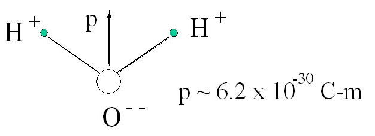



Next: Infrared
Up: Radiowave and Microwave
Previous: Cosmic Microwave Background Radiation.
Contents
Polar molecules like water
are influenced by any incident electromagnetic radiation, and such
molecules can be set
into vibrations or rotation by the external, oscillating electric field.
The water molecules try to align their dipole movement with the
external electric field which is oscillating. This sets the molecule
into rotation. The
rotational energy levels are quantized, and the molecules have distinct
frequencies at which there are resonances where the molecule emits
or absorbs maximum energy. The Microwave ovens utilize a
 rotational transition of water. The water molecules absorb the
incident electromagnetic radiation and start rotating. The rotational
energy of the molecules is converted to random motions or heat.
rotational transition of water. The water molecules absorb the
incident electromagnetic radiation and start rotating. The rotational
energy of the molecules is converted to random motions or heat.
Most of the rotational and vibrational transitions of molecules lie in
the microwave and Infrared (IR) bands.
The frequency range
 to
to
 is often called Tera
hertz radiation or T-rays. The water vapour in the atmosphere is
opaque at much of these frequencies. Dry substances like paper,
plastic which do not have water molecules are transparent to T- rays,
whereas it is absorbed by substances with water and is reflected by
metals which makes it suitable for various imaging applications.
is often called Tera
hertz radiation or T-rays. The water vapour in the atmosphere is
opaque at much of these frequencies. Dry substances like paper,
plastic which do not have water molecules are transparent to T- rays,
whereas it is absorbed by substances with water and is reflected by
metals which makes it suitable for various imaging applications.




Next: Infrared
Up: Radiowave and Microwave
Previous: Cosmic Microwave Background Radiation.
Contents
Physics 1st Year
2009-01-06


![]() to
to
![]() is often called Tera
hertz radiation or T-rays. The water vapour in the atmosphere is
opaque at much of these frequencies. Dry substances like paper,
plastic which do not have water molecules are transparent to T- rays,
whereas it is absorbed by substances with water and is reflected by
metals which makes it suitable for various imaging applications.
is often called Tera
hertz radiation or T-rays. The water vapour in the atmosphere is
opaque at much of these frequencies. Dry substances like paper,
plastic which do not have water molecules are transparent to T- rays,
whereas it is absorbed by substances with water and is reflected by
metals which makes it suitable for various imaging applications.